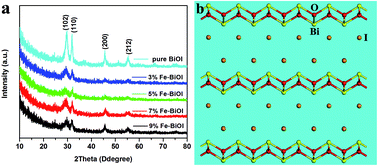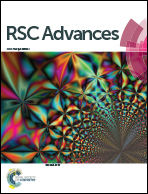One-step solvothermal synthesis of Fe-doped BiOI film with enhanced photocatalytic performance
Abstract
Ultrathin nanosheets consisting of Fe-doped BiOI were obtained on a FTO (SnO2:F) glass substrate via a simple solvothermal process. High-resolution transmission electron microscopic analysis indicates that the ultrathin nanosheets are exposed with {001} facets. The Fe-doped BiOI film has a higher photocatalytic activity for degrading Rhodamine B under visible light irradiation in comparison with the undoped BiOI films. The photocatalytic activity reached a maximum when the Fe doping concentration was 7%. It is believed that an optimal concentration of Fe3+ ions improves the electron–hole separation efficiency, hence improving the degradation rate of Rhodamine B. Scavenger test results indicate that the photo-generated h+ and ˙O2− play an important role in the degradation of Rhodamine B. A possible photocatalytic degradation mechanism for Rhodamine B by Fe-doped BiOI film is presented.


 Please wait while we load your content...
Please wait while we load your content...